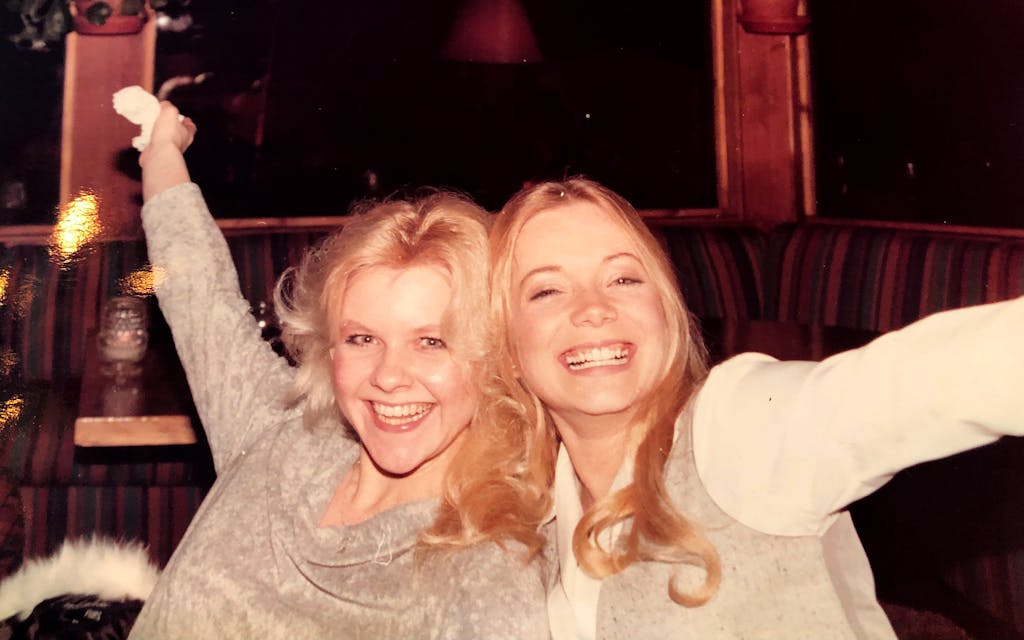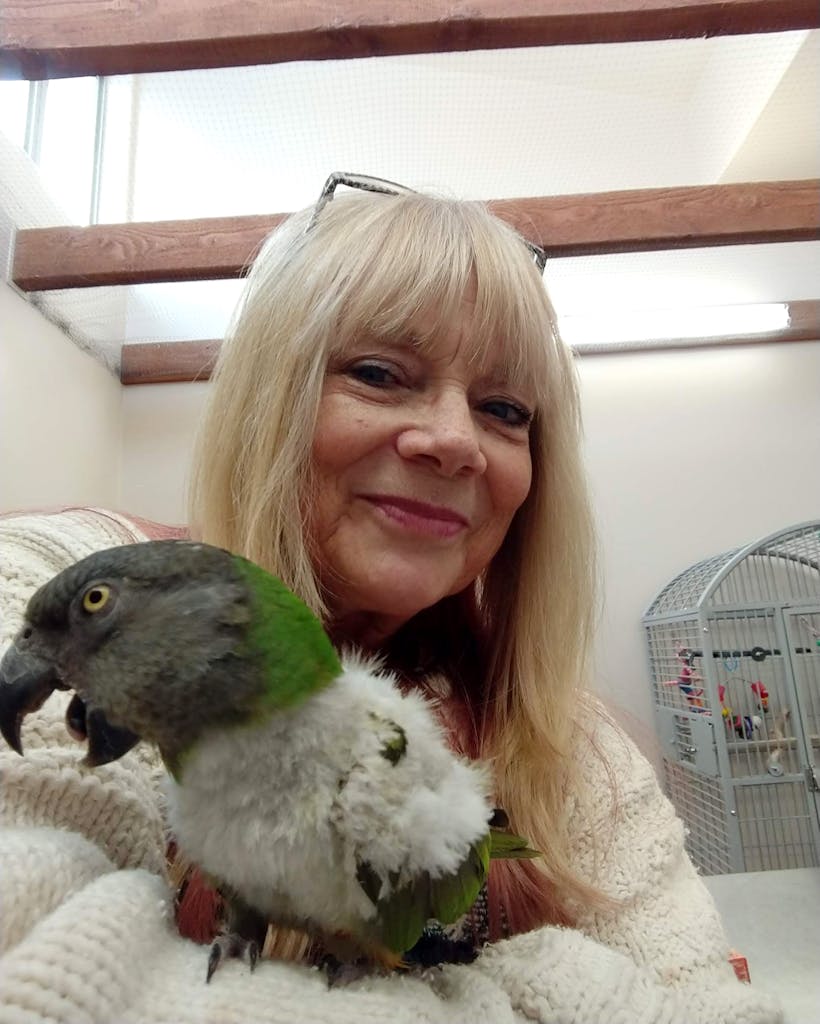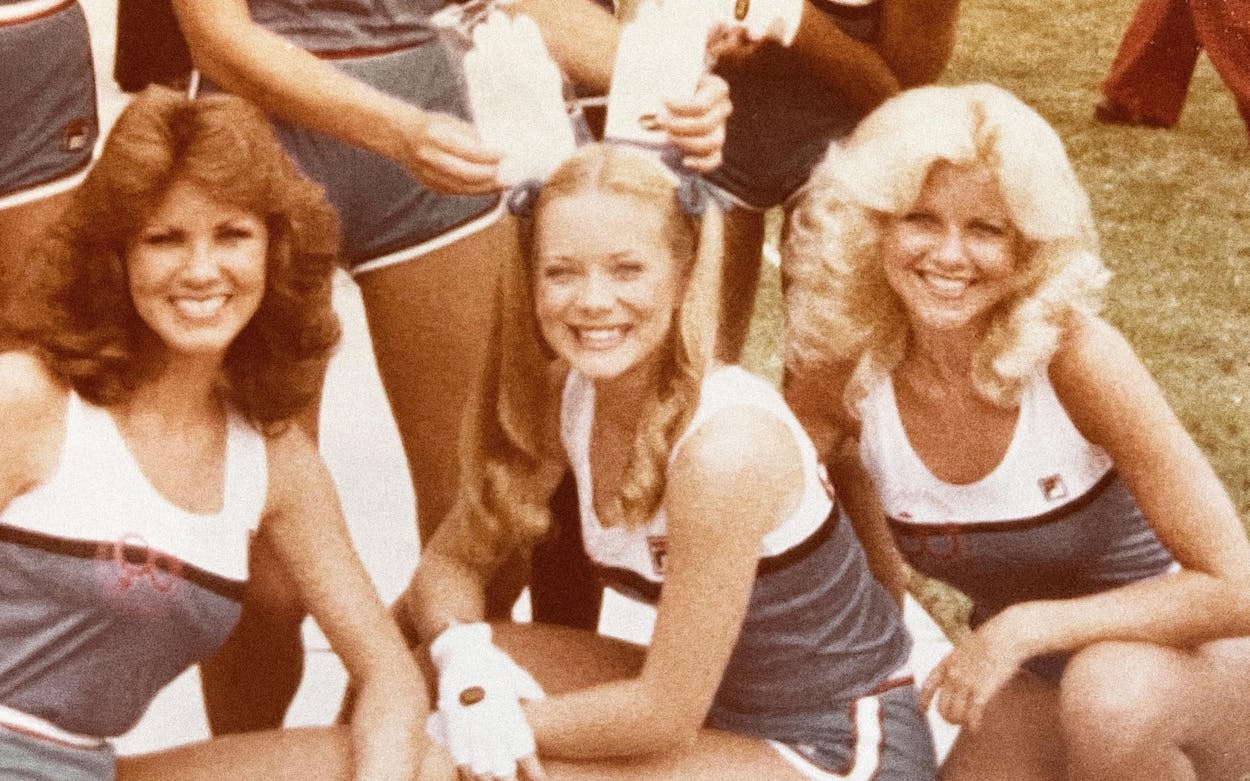Stories in this article are featured in episode two of our podcast America’s Girls. You can dive deeper into the stories from the show in our Pocket collection.
Subscribe
One day, not so long ago, Tami Barber shaved her head. She took scissors to the thick, once-blond hair that had been her trademark, cutting as close to the scalp as she could get, and then she took her dog’s grooming shears and plowed across her scalp until there was nothing left. She washed her head with a washcloth that day. She’d always wanted to do that.
This was about eight months after a diagnosis of ovarian cancer, and chemo left her hair coming out in clumps. She was tired of getting out of the shower and pulling out handful after handful. “I’m done with this,” she thought. So out came the shears.
She bought wigs to wear in public. One of them was pink. But the wigs itched her bare scalp, so she never wore them to chemo treatments at the infusion center, where she sat for long hours with her clean, cue-ball head, having learned something she wished she could convey to other women going through this.
“We aren’t our hair,” she told me. “And I’m speaking as someone who was nothing but her hair.”
Tami Barber was the Dallas Cowboys cheerleader with the pigtails. There have technically been many Dallas Cowboys cheerleaders with pigtails, but really, there was only ever one. Her look—a combination of little-girl innocence, blue-eyed beauty, and under-the-radar sexuality (very Britney Spears-in-a-Catholic-schoolgirl-uniform)—made her one of the most visible members of the squad during arguably its most visible era, the late seventies.
Tami was on posters and playing cards, and she often got a spotlight in the cheerleaders’ many TV appearances. For years after she left the squad, people came up to her. “Are you the cheerleader . . .” they’d start, putting their fists up to either side of their heads to signify where the ponytails would go. In fact, the curiosity about her is so enduring that I noticed the question coming up in related searches during my research. “Who is the Dallas Cowboys Cheerleader who wore pigtails?” Google answers Kelli Finglass, the current director, but Kelli had big eighties hair during her cheerleading years, something closer to that of the country singer Barbara Mandrell.
So try again, Google. The answer is Tami Barber.
Tami grew up in a small Nebraska town. “We were a Cowboys house,” she told me, although her team was the Los Angeles Rams. She went to college in Arlington, the Dallas suburb that was close to Texas Stadium. At the age of nineteen, after hearing a radio spot on KVIL, she went to audition for the cheerleaders, and beat out more than six hundred women for one of 36 spots.

The year 1977 was a turning point for the cheerleaders. They got a big spread in Esquire. The story was commissioned by associate editor Suzanne O’Malley, a Bishop Lynch grad who grew up in Dallas. Cheerleader Debbie Wagener graced that cover, looking like a glamorous sister to Blondie’s Debbie Harry, although in real life, Debbie Wagener was a grocery checker at Tom Thumb. The Dallas photographer on that shoot, a guy named Bob Shaw, took the photos to Cowboys general manager Tex Schramm, a P. T. Barnum type who liked the idea of a poster that could compete with that of Farrah Fawcett. The result was five cheerleaders in a V formation that sold about a million copies, and ramped up “the great cheerleading war of 1978,” when hot pants and bare midriffs became standard across the league. (We tell this story in episode one of America’s Girls.)
Tami Barber was not in Esquire, and she was not on that 1977 poster. She had a tomboy figure and stick-straight blond hair down her back. One day, in Tami’s second season, director Suzanne Mitchell brought her into the office. “We’ve decided you’re going to wear your hair in pigtails,” she informed her. Tami asked why, and the harsh words that came back to her are words Tami can recite to this day: “You’re not pretty enough, and you need a gimmick.”
Suzanne Mitchell is one of the more-complicated figures in the cheerleaders’ complicated story. (The documentary Daughters of the Sexual Revolution is a riveting homage to her legacy.) Both firebrand and deep traditionalist, both nurturer and taskmaster, Suzanne was the daughter of a military man who ran the cheerleading squad like a boot camp. She took wounded girls under her wing, but she was also known to show no mercy. One of the first female executives in the NFL, she had to be tough. A lot of former cheerleaders speak about her with a deep awe and reverence, but Tami not so much. “Suzanne Mitchell is a mean girl,” she told me.
Her mentor was Texie Waterman, the vivacious choreographer who often pulled Tami aside to comfort her. Texie and Suzanne had a bit of a good cop/bad cop thing going on. And, of course, Tami had her friends on the squad, including Vonciel Baker and Shannon Baker (not related, though it became a joke that they were).
“Tami was cool to me,” Shannon told me. “She smoked; she cussed; she was kind of like Texie a little bit.” Shannon was a straight-A student at Southern Methodist University, a high-achieving dancer, a girl with perfect, feathered bangs who scrapbooked every moment of her life. But Tami had a touch of the rebel. One day, after a game, Tami told Shannon to get in her car. If it wasn’t a Camaro, that’s too bad, because Shannon remembers it as a Camaro, the sleek, streamlined danger of a late-seventies sports car.
“We’re gonna get a drink,” Tami told her.
“In this?” Shannon pointed to their uniforms. The rules explicitly said cheerleaders were not to be seen in their uniforms near alcohol. The rules were very clear! But Tami tore off with Shannon in the passenger seat, and they pulled up to a 7-Eleven in their crop tops and hot pants and bought a six-pack, a middle finger to the system.
So Tami bucked a bit against the rules, but you have to give Suzanne credit: those pigtails worked. In a squad of women often seen as anonymously beautiful, Tami Barber stood out. She got fan mail from little girls in pigtails and little boys in Underoos. (Tami Barber’s amazing fan-mail stories are in episode two.) When the cheerleaders filmed a two-part episode for The Love Boat, the deliciously cheesy and super-popular cruise-ship romance that was the brainchild of 90210 and Charlie’s Angels creator Aaron Spelling (who grew in South Dallas), Tami got a featured role, as a cheerleader being stalked by her ex-boyfriend—though, this being the seventies, the couple winds up together. Tami’s good in that show. Natural, radiant, and those blue eyes of hers just pop.
Tami got the acting bug. And so after she left cheerleading in 1979, she tried her hand at making it in movies and TV. She started as an extra on the megahit Dallas. Her big break came when Charlene Tilton, the exceedingly blond actress who played ingenue Lucy, couldn’t drive stick shift in her little sports car. Well, Tami could. And she had that same long, flaxen hair, so she worked as Lucy’s stunt double, until they gave her a recurring role as Bev, Lucy’s friend.
She went to Hollywood, the place Suzanne Mitchell had warned the cheerleaders about. A cold town. Suzanne didn’t like cheerleaders using their time on the squad as a path to stardom; Suzanne was known to axe cheerleader candidates with too much thirst for fame. She wanted the Dallas Cowboys Cheerleaders to be a destination, not a stepping stone. And in the squad’s long history, very few women ever did move on to anything like a successful acting career. Tina Hernandez had a recurring role on the popular seventies cop show CHiPS. More recently, Abigail Klein starred in a Lifetime movie. Maybe the most successful of the bunch is Sarah Shahi, who cheered for less than a season before heading to L.A., where she was on The L Word and starred in the 2020 Netflix hit Sex/Life.
Tami would not be on the short list of cheerleaders who “made it.” But she found a satisfying career as an agent. She liked lifting up other people. And she liked Los Angeles, too. But she moved back to Nebraska in 1995 to care for her ailing parents. She was an only child, and they’d always been close. After they died, she opened a Pilates studio. She was divorced by then; no kids. “All my kids have fur and feathers,” she told me. Somewhere in this middle period, she found a whole new passion. She got a cockatiel.
“We call it the gateway bird,” she said. Cockatiels can sing and bop around their heads, but they won’t take off your finger if they bite. Eventually Tami graduated to macaws and cockatoos.
“They’re little tiny people,” she said. “They all have their own personality.”
She started rescuing birds. Parrots were those exotic creatures people fell in love with from the movies or television and then impulse-bought, only to discover how much work they took. “A lot of people see this cockatoo dancing and talking—‘Oh, I want one.’ And then they dump them,” Tami said.
A couple years ago, she saw a job listing for a parrot caregiver at Best Friends Animal Society. It’s a vast preserve of once-abandoned pets based in the spectacular red-rock canyons of Kanab, Utah, not too far from Zion National Park. She applied on a whim, and they scooped her up fast. It was a major shift. She sold her house, bought a camper, and moved to the middle of nowhere.
“It’s the most magical place,” she said.
But in November 2020, she got the cancer diagnosis. The c-word had taken a number of the women she knew from her cheerleading days. Texie Waterman died of lung cancer in 1996. Suzanne Mitchell, pancreatic cancer, 2016. A woman she had cheered with, a sweet brunette named Kim Kilway, died of ovarian cancer in September 2020, so things were getting scary. Tami had to drive 75 miles just to visit the hospital. The animal sanctuary was so remote she didn’t get cell-phone service. She had to go ten miles down the road just to get a signal. This wasn’t going to work.
She headed for New Orleans to live with her cousin. COVID-19 hit. You could say it was a rough year. She was in New Orleans when she finally shaved her head. But the humidity made her scalp sweat in those wigs, so she grew accustomed to going out in public with her shiny pate. Her hair eventually grew back to a salt-and-pepper buzz.
One day she was standing in line at CVS. “I love your hair,” a voice said, and she turned around to find a guy with a crew cut. “But I did mine on purpose,” he said, smiling. And she smiled back at him and said, “Well, so did I.”
I only got to meet Tami on Zoom. I wanted to drive out to meet her in person, but the pandemic and her health status made that impossible (though she was recovering nicely). We had two long Zoom conversations as cats and dogs made their cameo appearances on her lap and the corner of the screen. But I was disappointed not to meet Tami face-to-face, because she had a humor and a realness I’m hopelessly drawn to and that isn’t always easy to find in a group of women given strict instructions on how to behave. That’s a generational story, but also a very specific one.

“There was a bit of a thumb pushing you down,” she said of her time with the Dallas Cowboys Cheerleaders. “Don’t stand out too much. Don’t overdo. Never do anything on your own, ever.” Tami was quite outspoken about her time on the squad. The low pay, the strict rules. “I have to be honest about what went on there, because it was a part of my life and I’m proud of it, but yet it doesn’t define who we are. We all went on and had great lives.”
So she will always be Tami with the pigtails—but she is also Tami the parrot rescuer and Tami the ovarian cancer survivor and Tami who is currently playing around with the idea of a podcast. And whatever bad came with being one of the cheerleaders, it was so overshadowed by the good.
“Nothing in my life will ever compare to that time,” she said. “Nothing.”
I did see Tami in person once, just last month, from very far away. She’d come back to Dallas for the big, sixtieth cheerleader celebration at the November 14 game against the Atlanta Falcons. At 64, Tami was cancer-free and feeling good, and she always looked forward to alumni events. She loved connecting with the women from her past. It was a halftime show, and cheerleaders from each decade took the field to dance to songs from their era. In her blue-and-white Cowboys jersey and her short-cropped hair, Tami joined about a dozen other women from the seventies shaking their pom-poms to “Freak Out” and “Shake Your Groove Thing.”
“Please don’t watch the seventies girls,” she had messaged me when I told her I’d be there. “It’s too fast, and we’re too old LOL.”
But of course I was watching. Everyone was.
To hear Tami talk about her time on the squad, listen to episode two of America’s Girls, “All That Glitters.”
- More About:
- Sports
- Dallas Cowboys Cheerleaders
- Dallas






